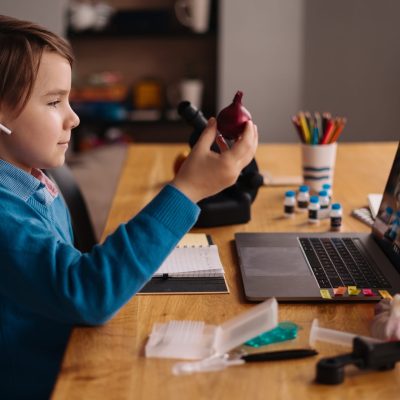Autistic students’ unique learning styles benefit from tailored homeschooling. It presents a world of custom opportunities. It enables the use of useful tools. These tools include visual aids, hands-on activities, and high-tech aids. They are all adjusted to children’s specific needs. This attention makes learning fun. It also boosts their thinking skills. Traditional schooling might not do this. But, the journey has bumps. It can pose special challenges, like creating the right sensory environment. Fortunately, the keys to navigate these waters are just a few clicks away.
Inhalt
- 1 Advantages and Interactive Elements of Autism Homeschooling
- 2 Addressing Challenges: Incorporating Sensory Activities and Structure
- 3 Facilitating Effective Communication in Homeschooling
- 4 Tailoring Curriculum and Learning Resources for Autism
- 5 Impact of Homeschool Programs on Autistic Development
- 6 Exploring Social Benefits of Homeschooling for Autistic Children
Advantages and Interactive Elements of Autism Homeschooling

Homeschooling your child with autism has many unique benefits. You can’t overlook them. One key advantage is the personalized attention your child receives. In homeschool, you can customize the curriculum. It to meet your child’s needs, interests, and style. This much customization is often not possible in traditional schools. Teachers there have to focus on larger groups of students with diverse needs.
Furthermore, flexibility is a major advantage of homeschooling for autistic children. You can change the schedule to accommodate sensory sensitivities or other challenges. Your child may have them. For example, if your child has trouble with transitions. You can limit abrupt changes by structuring the day. This will greatly reduce your child’s stress and anxiety. It will also create a better place to learn.
Another key difference is the ability to create an environment for autistic children.
Adding interactive elements, like visual aids and hands-on activities, can help. So can assistive technology. They make learning better for children with autism. It makes learning more engaging and effective. Visual aids, such as charts, diagrams, and flashcards, help reinforce concepts. They also improve comprehension. Hands-on activities provide chances to use what you’ve learned. They can also improve sensory-motor skills. Additionally, assistive technology tools can assist with communication, organization, and academic tasks.
You can add these interactive elements to the curriculum. These strengths and challenges form the foundation for your child.
One great thing is the many resources for homeschooling autistic kids. Tailor the learning environment to meet their needs. This lets you create an inclusive space that helps growth.
Our website has a full list of interactive resources and learning materials. Educators make them for homeschooling autistic students. We strive to empower parents and educators. We give them the tools they need. They use them to create engaging and effective learning for their children.
We continue to explore homeschooling for autistic children. It’s clear that this approach offers many tailored benefits. These can profoundly affect their education.
Addressing Challenges: Incorporating Sensory Activities and Structure
When homeschooling an autistic child, use sensory activities. Provide a structured environment. These things are vital for their well-being. Sensory activities are essential for helping autistic children regulate their sensory input. This input greatly affects their ability to focus on learning tasks.
Autistic children often experience sensory sensitivities that impact their daily lives. For example, certain sounds, textures, or even lighting may cause discomfort or overstimulation. It’s crucial to tailor the homeschooling environment to accommodate these sensitivities. Parents can create a safe learning space for their child’s needs. They can do this by adding sensory activities. These activities will help the child focus and reduce anxiety.
Structured routines are also great for autistic children. They thrive in places that are predictable and consistent. When homeschooling, parents can create daily schedules and routines. They can make ones that fit their child’s preferences and needs. This approach is adaptable. It enables them to add sensory breaks and activities at the best times. This ensures the child stays regulated and engaged in their learning.
For instance, adding sensory-friendly elements to the homeschooling environment can help. These include things like adjustable lighting, noise-cancelling headphones, and fidget tools. They can reduce sensory overload during learning. Also, setting aside areas for calming activities can help. So can setting aside areas for movement breaks. These things can give the child the sensory support they need. It does this while keeping structure in the homeschool routine.
You can add sensory activities and routines to the homeschooling curriculum. They can help autistic children learn better. Parents can do this. This will create a supportive environment. It will be good for their academic and personal growth.
Communication is vital. It helps tailor an environment to the unique needs of an autistic child. Let’s now explore how to help communication in homeschooling. It will further support the growth of children on the autism spectrum.
Facilitating Effective Communication in Homeschooling

Good communication is crucial in any school. It’s especially vital for autistic children. Homeschooling creates a unique chance. It lets you tailor communication to individual needs. You do this in a comfortable and familiar place. Visual aids work well. They give a structured way to share info.
Visual schedules, social stories, and visual aids can work wonders. They help autistic learners understand and engage with their homeschool lessons. Visual schedules outline the events of the day or specific tasks in order. They provide clear expectations and reduce anxiety by making the day more predictable. Social stories use simple language and pictures. They explain social situations or concepts. These may be hard for the learner to grasp. These stories can help with specific sensory issues. They can also prepare the learner for new experiences.
For instance, a visual schedule can show an autistic learner what they will do. It shows the activities for the whole day. This can reduce anxiety. They know what’s coming and can anticipate transitions. A social story could show how to behave in common social situations. These include going to the grocery store or meeting new people.
Our website offers downloadable visual resources. It also offers tips for using them well in homeschooling. These resources aim to promote understanding. They reduce anxiety and create positive communication for autistic learners.
It’s important to understand that every child with autism is different. So, it may take some trial and error to find the best visual tool or tool combo for your child’s needs.
In upcoming articles, we’ll discuss how to integrate these visual tools into homeschooling. We’ll provide concrete tips and real examples from other successful home educators. They work with autistic learners.
We are entering the world of customized education for children with autism. We’ll see how special curriculum and resources are crucial to their academic journey.
Tailoring Curriculum and Learning Resources for Autism
When homeschooling an autistic child, one size does not fit all. Each child has their own unique strengths, weaknesses, and sensitivities. Tailoring the curriculum to meet a child’s individual needs is crucial. We can create a plan just for them. We do this by understanding the child’s interests, challenges, and how they learn. It will make their education better.
Imagine it this way. If a child loves dinosaurs, you can use dinosaur-themed materials. You can use them to teach various subjects. Students calculate dinosaur footprints in math. They read about dinosaurs in language arts. They study them in science. This captures the student’s interest. You can then tailor the content to be more engaging and enjoyable.
Also, some autistic children may have sensory sensitivities. These make traditional learning materials hard to engage with. Therefore, providing sensory-friendly materials can help. These include noise-canceling headphones, fidget tools, and textured educational resources. They can create a comfortable learning environment.
Our website offers a curated list of learning resources. Designers created them for autistic children. This includes adaptive educational software. It can adjust to a child’s pace and level of understanding. There are also sensory-friendly materials to accommodate sensitivities. Modified curriculum options exist. They ensure individualized learning tailored for autistic students. These tools help parents create a supportive learning environment at home. They are encouraging.
Tailor the curriculum to fit each child’s abilities and interests. This can create a rich and accommodating learning environment. It promotes growth and success for their autistic children.
The tailored approach to homeschooling ensures that it meets the needs of each child. It makes for an enriching education. Moving forward, we’ll delve into the impact of homeschool programs on autistic development.
Impact of Homeschool Programs on Autistic Development

Homeschooling offers a rare chance for autistic children to thrive. They do so in a safe and cozy place tailored to their needs. It goes beyond just academic learning. The home-based setting fosters security and routine. This can greatly reduce anxiety and stress for individuals with autism.
Traditional schools often have lots of sensory and social pressures. The absence of these pressures often reduces anxiety for autistic learners. Homeschooling creates a calm, familiar space for learning. It helps nurture emotional well-being and mental health. This type of supportive environment caters to positive development. It lays the foundation for progress.
Also, homeschooling is flexible. It lets parents easily add therapy to the daily routine. This lets kids get steady support from their parents or therapists. It avoids the disruptions that happen in a normal school.
For instance, children benefit from speech therapy and occupational therapy. They can do these activities at home, where they are comfortable and familiar. This ensures regular therapy sessions. It also stops stress from moving between places.
Homeschooling offers personalized attention and support. It empowers autistic learners to embrace their strengths and interests. We can change the curriculum to suit the child’s style and preferences. This allows them to progress at their own pace without feeling rushed or overwhelmed. This approach fosters a more positive attitude towards learning. It also boosts engagement with educational materials.
Homeschool programs often use visual aids, hands-on activities, and multisensory learning. They do this to fit the varied learning styles of autistic children. This custom approach makes learning easier. It also helps people understand concepts better through interactive experiences.
Homeschool programs impact more than academics. They also create an environment that supports well-being. They provide tailored therapy and encourage growth in autistic learners.
We have explored the impact of homeschool programs on autistic development. Now, let’s shift to the social benefits of homeschooling for children with autism.
Exploring Social Benefits of Homeschooling for Autistic Children
Social interactions can be tough for some autistic children. The noise, the lights, and all the people can be overwhelming. That’s where homeschooling can make a real positive difference.
One big benefit of homeschooling is that you get to control your child’s social life. You do not leave them to navigate it on their own. This means planning carefully. You will plan managed social activities. They should fit your child’s comfort and preferences.
Creating a supportive environment is critical. Educators must tailor it to the unique social needs of students with autism. This is key to their well-being.
Our website
For instance, setting up play dates in small groups or one-on-one can help an autistic child feel more at ease. Also, activities like art classes, music lessons, or nature walks can also help. They let homeschooling families interact safely but in a way that enriches.
The goal is not to overwhelm. Instead, it is to gradually expose autistic children to different social situations. We do this in a safe and supportive way. In these managed interactions, they can learn social cues. They can practice communication and build friendships. They can do all this at a pace that suits them.
Also, homeschooling is flexible. It lets parents tailor social experiences to their child’s unique strengths and challenges. For example, if an autistic child loves animals, visits to a farm or nature reserve. They could be a great chance to interact with animals.
This tailored approach helps build confidence. It gives a sense of accomplishment. Children do activities that align with their interests and comfort levels.
Homeschooling provides these controlled social interactions. They can help the well-being of autistic children.
In conclusion, homeschooling plays a key role. It does this by providing an environment for the special needs and strengths of autistic children. This environment nurtures their social skills and overall well-being.
Der zukünftige Erfolg Ihres Kindes ist unser oberstes Ziel bei Legacy Online School. Besuchen Sie unser Website um die vielen Möglichkeiten der Legacy-Onlineschule zu erkunden.
Informieren Sie sich über die Online-Schulprogramme von Legacy:
Die Grundschule der Legacy Online School Programm legt die Messlatte hoch. Dies ist eine hochwertige Ausbildung. Wir sind bestrebt, Neugier zu wecken. Wir bemühen uns auch, die Kreativität zu fördern. Wir bieten einen soliden Lehrplan. Unterstützt werden wir dabei von qualifizierten Pädagogen.
Legacy Online Mittelschule bietet digitale Bildung. Sie ist für Schüler der Mittelstufe gedacht. Die Schule ist stolz darauf, Live-Online-Kurse anzubieten, die von zertifizierten Lehrern unterrichtet werden. Der Unterricht findet online und interaktiv statt.
Legacy Online High School ist eine einzigartige Methode des Online-Lernens, die speziell für Oberstufenschüler entwickelt wurde. Sie kombiniert synchrones Lernen, ein breites Spektrum an pädagogischen Methoden und einen Schwerpunkt auf Zugänglichkeit.
Die Legacy-Onlineschule bietet das Beste Lehrplan
Unser strenger Lehrplan gewährleistet, dass die Absolventen gut auf Universitäten und Arbeitsplätze in der ganzen Welt vorbereitet sind. Darüber hinaus verbinden unsere dynamischen virtuellen Clubs Studierende auf der ganzen Welt.






